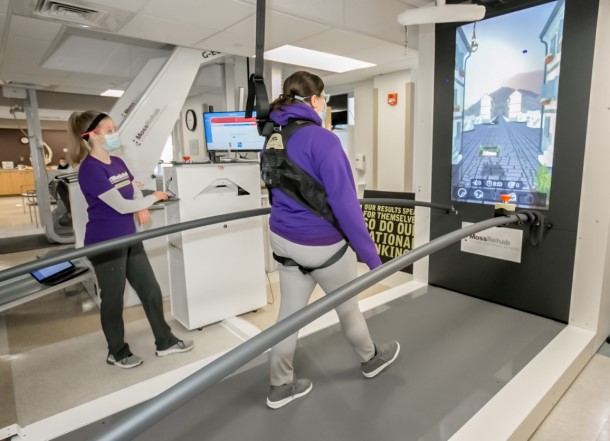
Research shows that repetitive, task-specific exercise helps improve body and cognitive functions for individuals recovering from a stroke, traumatic brain injury, or other neurologic disorder. However, people often get bored doing the same activities over and over and lose motivation to complete exercises at the required duration and intensity to meet their rehabilitation objectives. Enter therapeutic gaming with enhanced reality.
This new generation of therapy equipment features computer-based therapeutic games to engage patients in working harder and longer in their rehabilitation. MossRehab therapists already have access to a collection of therapy gaming devices throughout the network. The C-Mill VR+ by Motek is the latest addition that features augmented and virtual reality applications for gait and balance training. Installed in January 2021 at MossRehab Elkins Park, the C-Mill offers varied interactive standing, stepping, and walking activities to simulate everyday circumstances and engage patients in their rehabilitation.
“The VR programs of the C-Mill make therapy fun with engaging visual and audio stimuli. Patients become more immersed and involved in activities to help them work harder and longer,” explains Andy Packel, PT, NCS, locomotor coordinator at MossRehab. “Patients with pain or limited attention span also benefit as the virtual environment captures their attention to become more involved in rehabilitation activities.”
Intended for stroke, neurologic and vestibular patients with walking and balance challenges, the C-Mill VR also is used for post-surgical patients such as those with ACL repairs. “The C-Mill is turning out better than expected as it can support patients with different diagnoses,” notes Matthew Vnenchak, PT, MS, NCS, who has worked in outpatient physical therapy at MossRehab Elkins Park for over 15 years. “In addition to improving patient engagement, the simulation aspect of the C-Mill takes our patients to the next level of therapy to prepare them for the unpredictable nature of the real world.”
A High-Tech Treadmill that Augments VR
The C-Mill is an oversized treadmill, with an extra-wide and longer treadmill belt. A large LCD screen displays virtual reality applications focused on balance, walking, and dual tasking. Adding a second dimension in therapy, the C-Mill also can display targets or obstacles on the treadmill to increase the challenge of rehabilitation. An optional dynamic bodyweight support system (harness) can bear a patient’s body weight, helping individuals with walking limitations or needing to work on dynamic balance.
“The treadmill belt is huge and allows us to have patients move to the left and the right as well as to the front and the back of the treadmill,” says Vnenchak. “These features give us a whole new set of tools when it comes to treatment.”
Offering an assortment of applications that address different motor learning skills, the C-Mill enables therapists to customize game variables to match a task and training intensity appropriate to a patient. Some basic therapeutic games – like one that resembles the old “pong” game – prompts patients to shift their weight side to side, while more dynamic applications require individuals to complete more challenging tasks.
For example, an Italian Alps game displays different pizza toppings on the LCD screen that patients must collect along a path in a village. For those with higher skill levels, the application can project obstacles and/or targets on the walking belt that patients must navigate while completing tasks on the screen. The C-Mill detects patient walking patterns. “In everyday life, we are dual-tasking – walking while carrying a phone or holding a conversation,” says Packel. “A patient can walk on the C-Mill while directing their attention to other tasks such as navigating an environment or avoiding targets.”
Vnenchak describes a case where the C-Mill offered the motivation needed for a patient with a brain injury to become more involved with therapy for more intensive rehabilitation treatment. “I have a young patient who has a problem maintaining attention due to her neurologic condition,” explains Vnenchak. “However, in the therapeutic gaming environment, she can pay attention for an entire hour as the applications are so stimulating.”
Feedback Guides Therapists in Treatment
Therapists initially assess patients on the C-Mill by having them complete snippets of games to determine the best applications. PTs also receive objective measurements from completed therapy to assess a patient’s progress regarding balance, gait, walking symmetry (how even walking is comparing the left to the right side), and distance walked. Using short- and long-term results, therapists can make insights to determine the next steps for future therapy sessions. Vnenchak provides an example.
“A patient with weakness on one side of the body after a stroke or limps due to a recent surgery may favor one side and walk with uneven strides and weight application. The C-Mill gives us an objective measure of these issues by indicating if they are not putting equal weight on each leg or taking uneven steps,” explains Vnenchak. “To treat this issue, we can project footprints on the treadmill in the pattern in which the patient is currently walking and then, move those targets overtime to correct the problem. For patients, the visual description of their walking issues makes more sense than a verbal description.”
Vnenchak shares that both patients and fellow therapists are very happy with the C-Mill and anticipates its use with more and different patients down the line. While a sophisticated machine, simple operation and set-up make it appealing to therapists and patients.
The C-Mill joins MossRehab’s other advanced technology therapy equipment for gait training including the Tyromotion OMEGO, Hocoma Lokomat, SafeGait and Andago, Thera-trainer Lyra, and Balo, and Rehab G-EO devices. “One of the reasons I’ve worked at MossRehab for so long as a therapist is because of all the innovation introduced in our practice to help patients achieve their goals,” says Vnenchak.
Check out MossRehab’s extensive collection of robotics used in rehabilitation.